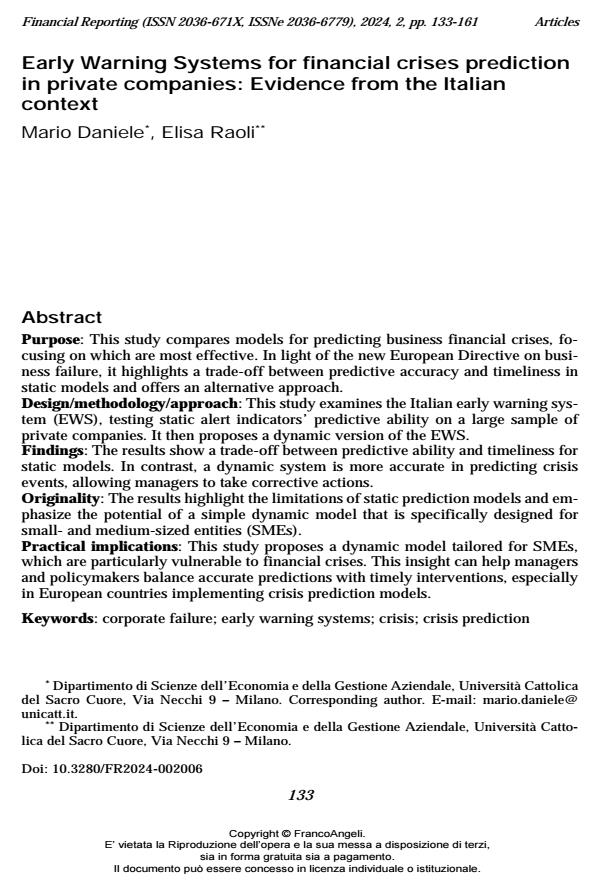Early Warning Systems for financial crises prediction in private companies: Evidence from the Italian context
Journal title FINANCIAL REPORTING
Author/s Mario Daniele, Elisa Raoli
Publishing Year 2024 Issue 2024/2
Language English Pages 29 P. 133-161 File size 222 KB
DOI 10.3280/FR2024-002006
DOI is like a bar code for intellectual property: to have more infomation
click here
Below, you can see the article first page
If you want to buy this article in PDF format, you can do it, following the instructions to buy download credits

FrancoAngeli is member of Publishers International Linking Association, Inc (PILA), a not-for-profit association which run the CrossRef service enabling links to and from online scholarly content.
Purpose: This study compares models for predicting business financial crises, fo-cusing on which are most effective. In light of the new European Directive on business failure, it highlights a trade-off between predictive accuracy and timeli-ness in static models and offers an alternative approach. Design/methodology/approach: This study examines the Italian early warning system (EWS), testing static alert indicators’ predictive ability on a large sample of private companies. It then proposes a dynamic version of the EWS. Findings: The results show a trade-off between predictive ability and timeliness for static models. In contrast, a dynamic system is more accurate in predicting cri-sis events, allowing managers to take corrective actions. Originality: The results highlight the limitations of static prediction models and emphasize the potential of a simple dynamic model that is specifically designed for small- and medium-sized entities (SMEs). Practical implications: This study proposes a dynamic model tailored for SMEs, which are particularly vulnerable to financial crises. This insight can help managers and policymakers balance accurate predictions with timely interventions, especial-ly in European countries implementing crisis prediction models.
Keywords: corporate failure; early warning systems; crisis; crisis prediction
Jel codes: G01, M4, M400, M410, M480
- Leveraging the tax shield: Capital structure decisions in privately-held firms Anna Alexander, Luca Menicacci, in FINANCIAL REPORTING 2/2025 pp.27
DOI: 10.3280/fr202519852 - Proximity and Financial Distress: Evidence from Debt Renegotiations in Italian SMEs Carlotta Magri, Federico Bertacchini, Gianluca Gabrielli, in FINANCIAL REPORTING 2/2025 pp.221
DOI: 10.3280/fr202519806 - Ownership structure and financial default risk in Italian private firms Velia Gabriella Cenciarelli, in FINANCIAL REPORTING 2/2025 pp.165
DOI: 10.3280/fr202520028
Mario Daniele, Elisa Raoli, Early Warning Systems for financial crises prediction in private companies: Evidence from the Italian context in "FINANCIAL REPORTING" 2/2024, pp 133-161, DOI: 10.3280/FR2024-002006